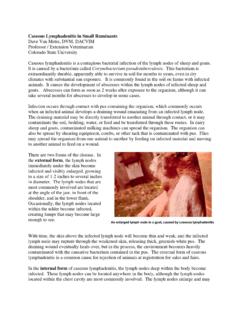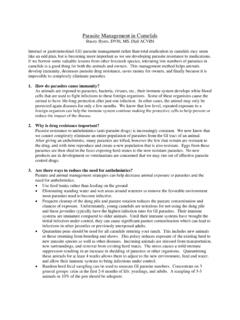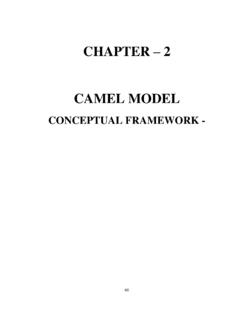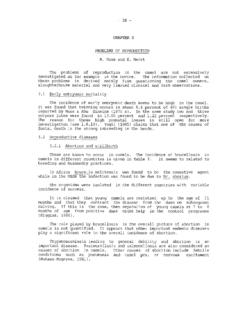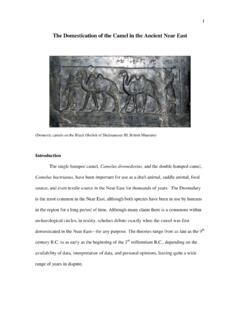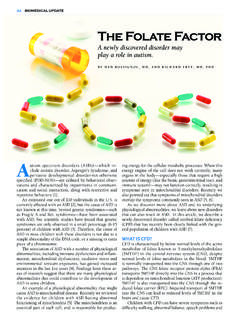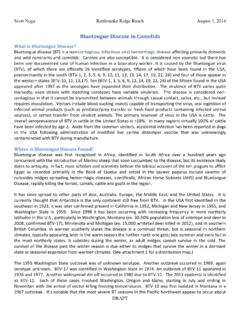Transcription of Vaccinations in Camelids Dr. Stacey Byers, DVM, MS, Dipl …
1 Vaccinations in Camelids Dr. Stacey Byers, DVM, MS, Dipl ACVIM Vaccines are a common way to provide individual and herd immunity to a variety of bacteria or viral agents. Vaccines should be used to complement, but not replace good management techniques for disease prevention such as biosecurity, herd health checks, nutrition, stocking densities, etc. There is a lot of confusion about vaccines especially for Camelids since there are not any developed specifically for these species. All of the vaccines used in Camelids have been developed for cattle, small ruminants, and horses.
2 Therefore using these products is considered off label in Camelids and the manufacturers do not guarantee effectiveness and safety. Owners should always consult with their veterinarian to determine an appropriate vaccination protocol and which products to use. The following material is intended to provide some information on the different types of vaccines available. Vaccines have been developed to boost the immune system against specific infectious agents such as the influenza vaccine in people. These products may not prevent an infection but decrease the amount of illness produced.
3 Individual animals may still become ill following vaccination but the overall herd is more protected against infection. Over the years, research has led to different types of vaccines such as killed or toxoid, modified live, and recombinant products. A killed or toxoid vaccine contains killed or parts of killed bacteria or viruses. This type of vaccine is relatively safe and is preferred for pregnant animals. The immune response the animal develops after receiving a killed vaccine is not very strong so boosters are required 2-4 weeks after the first shot and then usually once a year after that.
4 Animals sometimes develop vaccine site reactions, such as lumps, due to the additional ingredients in the vaccine. Modified live vaccines contain portions of the bacteria or virus. The vaccine is designed to cause a mild infection in the animal which leads to an improved immune response as compared to a killed vaccine. This type of vaccine should not be used in Camelids at this time since the vaccines were designed for use in a particular species. Use in other species increases the risk for adverse reactions.
5 Recombinant vaccines are some of the newest vaccines available. They use a second organism to reproduce a small portion (a protein usually) of the virus or bacteria. These are considered very safe since the protein cannot cause an actual infection but stimulates the immune system to recognize the protein when it is attached to the infectious virus or bacteria. These types of vaccines are still relatively uncommon so there is not much information regarding their use in Camelids . Owners must remember that vaccines do not provide 100 percent protection against infections and many factors determine how much protection is provided.
6 Individual animal respond to a vaccines in different ways due to factors such as stress, immune status at time of vaccination, and proper storage and administration of the vaccine. Camelids that will be experiencing a stressful event such as a show or transportation should be vaccinated several weeks before the event to ensure a good response to the vaccine. It is also not a good idea to vaccinate a sick camelid since the animal will not develop as good of an immune response as well as a healthy herdmate. These animals should be vaccinated 2-3 weeks after recovering from the illness.
7 Maternal antibodies found in colostrum can interfere with some vaccines so additional boosters are often required for crias. A general guide explaining Vaccinations is available from the University of Nebraska-Lincoln Extension office at CD/T or 3-way Vaccine Clostridium perfringens type C, D, and C. tetani This is a commonly used killed vaccine and provides good protection against two types of Clostridium perfringens. This bacteria causes diarrhea and sudden deaths in crias and adults. Clostridium tetani causes tetanus, and all animals are at risk following infections that occur primarily through wounds, castrations, etc.
8 There are various vaccination schedules used. One plan recommends vaccination of adults once a year; pregnant females 4-6 weeks before to parturition; crias at 3-4 months old and again 4 weeks later then yearly thereafter. A second plan is based on vaccinating adults once a year; breeding females when they are open; and crias at 2-3 days old, again at 2-3 weeks old, and yearly after that. Other protocols can be used and tailored to suit individual farm situations. Clostridium perfringens Type A Toxoid This is a killed vaccine for use in cattle.
9 The vaccine was evaluated in alpacas at Washington State University Veterinary Teaching Hospital. No adverse reactions were seen, however the product was NOT evaluated on pregnant animals. Titers were measured and results indicated an immune response occurred but the degree of protection provided was unknown. It is not needed unless a ranch has had previous problems with this type of C. perfringens. Other Clostridial Vaccines 7 way and 8 way clostridial vaccines are available. The number refers to the number of diseases the vaccine protects against so these work against a larger number of clostridial bacteria.
10 These vaccines can be used instead of the CD/T vaccine. Vaccine site reactions (lumps) have been reported with some products. West Nile Virus Alpacas are considered at low risk of developing clinical signs after infection with West Nile virus. However the most common signs of infection are neurological which usually leads death of the animal even with intensive medical treatments. It is recommended to give the vaccine prior to the mosquito season and boost once more the second year. Since West Nile virus is endemic (found everywhere) in Colorado, Camelids will develop a natural immunity by exposure to infected mosquitoes in addition to Vaccinations .


